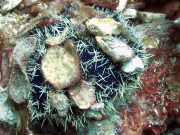Diving with Toxopneustidae Sea Urchins
Lanta Marine Life | Toxopneustidae
Toxopneustidae Sea Urchins have an internal skeleton made of overlapping plates which form a globular shape. Occasionally spotted during our Koh Lanta dive trips.
The outer shell of this family are covered with short moveable spines, with tiny pedicellariae (pincers) located between the spines. Some species have a toxic venom within these pincers which is used for defence.As with all other Sea Urchins, the mouth of Toxopneustidae Sea Urchins contains a complex chewing apparatus consisting of 5 jaws, known as an Aristotle's Lantern.
Toxopneustidae Sea Urchins use their tube feet and movable spines to move and are found in various colours, including black, blue, green, orange, pink and green up to 15 cm in diameter.
The Toxopneustidae Sea Urchins are herbivorous grazers, feeding on algae, detritus and sea grasses. In turn they are preyed upon by fish, gastropods and sea stars.
Another unusual adaptation in this Family is the attaching of foreign objects on to the top (arboral) surface of the shell. These species use their pedicellariae (tiny pincers) to pick up, and hold onto, pieces of algae, coral rubble, human rubbish or shell fragments. These objects may help to provide camouflage, armor, or sun protection for the urchin.
1 species found on this page:
Collector Urchin
(Tripneustes gratilla)

Tripneustes gratilla @ Koh Haa
Collector Urchins (sometimes known as Cake Urchins) have a blue, purple to brown body, covered with mostly short white or reddish/brown spines sometimes tipped with orange, and brownish-red tube feet.
The spines are alternated by vertical bands of tiny pincers (pedicillaria) which allow Collector Urchins to collect debris from around the reef (hence the common name).
Collector Urchins grow to 10 cm and generally feed on algae and seagrass. They are themselves preyed upon by pufferfish and octopus and are less commonly seen at the dive sites around Koh Lanta.
Diving with Toxopneustidae Sea Urchins around Koh Lanta
Scuba Diving & Snorkel Trips
If you'd love a chance to spot Toxopneustidae Sea Urchins on one of our daily high season diving trips from Koh Lanta then send us an email to info@diveandrelax.com.
Join our high season speedboat dive trips to some of Thailand's best dive sites and enjoy small groups, short journey times, with a focus on great personal service, safety and fun.
Not yet a certified diver? Learn to Scuba Dive on Koh Lanta with the 3 day SSI Open Water Diver course.
Book online to save 10% on dive trips and scuba courses on Koh Lanta.
Find Out More
Indo-Pacific Marine Life Guides
- Allen, G., Steene, R., Humann, P., DeLoach, N. (2003) Reef Fish Identification, Tropical Pacific. Jacksonville, FL., USA: New World Publications, Inc., ISBN 1-878348-36-1.
- Humann, P., DeLoach, N., (2010) Reef Creature Identification, Tropical Pacific. Jacksonville, FL., USA: New World Publications Inc., ISBN 978-1-878348-44-9
- Debelius, H. (2013) Indian Ocean Reef Guide. Frankfurt, Germany: IKAN - Unterwasserarchiv, ISBN 978-3-939767-52-7.
- Debelius, H. (2004) Nudibranchs and Sea Snails, Indo-Pacific Field Guide. Frankfurt, Germany: IKAN - Unterwasserarchiv, ISBN 3-925919-51-1
- Erhardt, H., Knop, D. (2015) Corals Indo-Pacific Field Guide. Frankfurt, Germany: IKAN - Unterwasserarchiv, ISBN 3-925919-69-4.
- Veron J.E.N., Stafford-Smith M.G., Turak E. and DeVantier L.M. (2016). Corals of the World
